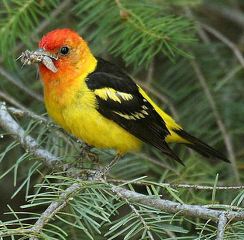 There are many common birds here – including the two species of Nuthatches, Mountain Chickadees, American Robins, Steller’s Jay, Acorn Woodpeckers, Band-Tailed Pigeons, Lesser Goldfinch, and Pine Siskins. But some species are harder to spot, and four of those are the subject of this article.
There are many common birds here – including the two species of Nuthatches, Mountain Chickadees, American Robins, Steller’s Jay, Acorn Woodpeckers, Band-Tailed Pigeons, Lesser Goldfinch, and Pine Siskins. But some species are harder to spot, and four of those are the subject of this article.
The Brown Creeper was one of the first birds I saw when we were house hunting in Munds Park. That is rather surprising, because since then I’ve only seen a Brown Creeper once or twice each year. It is like a Nuthatch in that it clings to and climbs on trees searching for insects, larvae, nuts, and seeds, but there are some major differences. First, the Brown Creeper has drab, streaky brown upperparts and is rather slender. It’s a very quiet bird and solitary – contrast that to the noisy little Pygmy Nuthatches that arrive in a group at our feeders. The biggest difference in my opinion is that it creeps up a tree – almost always up.
A second hard-to-see bird is the Red Crossbill. The first time I saw this one was at Kathy and Cindi’s house on Turkey Trail a couple of summers ago. This last month when I was driving on the cart path on hole 18 at Pinewood Country Club on a Friday, I saw a reddish bird in the path in front of me. It flew up into a pine tree, and I got my binoculars on it and confirmed – a Red Crossbill. Red Crossbills are a medium-sized finch with a red-orange body, bright red rump, and dark brown wings. But what is really distinct are their bills, which are crossed at the tip, enabling them to pry seeds from the cones of junipers and spruces.
The third species was reported to me by Lu on Lake Odell, who sent in a photo, and Martha on Reindeer, who saw it at her birdbath. It is the Western Tanager, a bird with a brilliant red head, bright yellow body, and black back, wings and tail. When this bird appears, you utter a “wow” because it is so striking. It is found only in the Western parts of the continent and migrates all the way to Central America. This species was first recorded on the Lewis and Clark expedition from 1803 to 1806.
The last species as part of this article is the White-Faced Ibis. It is a medium-sized wading bird that occasionally shows up at the ponds on the Pinewood Country Club golf course or in the marshy area near the Pinewood Sanitary District. Carol A. told me she saw one while golfing in July, and I had the pleasure of seeing one in about the same spot a few years ago. The white face is only a thin band of white feathers around its bare, red face. The rest of its body is a dark brown with a sheen or gloss that shows up in the right light as bronze or green. It hunts for invertebrates like insects, worms, snails, and also frogs and small fish. The White-Faced Ibis nests in colonies, so usually you will find more than one at a time.
One thing in common about all these species is that they are monogamous. How do we know that? Well, for me, I just read the research papers and believe the ornithologists who figure that all out. But I did learn that there are at least two types of “monogamous” when it comes to birds: mating for life (e.g., Canada Geese who may not even migrate if their mate has died), and serial monogamy (when a bird mates with another for one season but finds a new mate the next season). I hope you learned something new with this article, and as for me, I always find a tidbit or two that keeps me on my toes when it comes to the birds in Munds Park.

